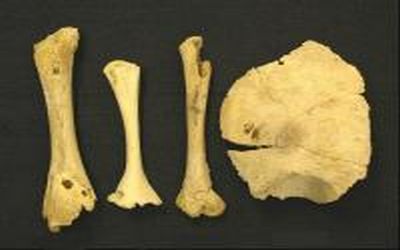Searching for an Ancient Syphilis DNA in Newborns
The ancient bones of newborns are very useful to recover the ancient DNA of the bacteria causing syphilis, the Treponema pallidum pallidum. This is the conclusion reached by a study led by Universitat Autònoma de Barcelona (UAB), which was able to obtain the genetic material from the bacteria in more than one individual, in what is considered to be the oldest case known to date. Several previous intents had only achieved to yield this material in one occasion and from only one individual.


Pictured are the left femur, two right humerus and a right hemifrontal bone belonging to at least two newborns found at "La Ermita de la Soledad " in Huelva. All show signs of bone lesions diagnosed as congenital syphilis. Photo by Universitat Autònoma de Barcelona
The ancient bones of newborns are very useful to recover the ancient DNA of the bacteria causing syphilis, the Treponema pallidum pallidum. This is the conclusion reached by a study led by Universitat Autònoma de Barcelona (UAB), which was able to obtain the genetic material from the bacteria in more than one individual, in what is considered to be the oldest case known to date. Several previous intents had only achieved to yield this material in one occasion and from only one individual.
Studying syphilis represents a challenge for researchers, in part because of the impossibility of using or genetically manipulating cell cultures, given that the subspecies of T. pallidum cannot be differentiated morphologically using immunofluorescence or electron microscopes. This makes diagnosis extremely difficult and complicates epidemiological and phylogenetic analyses. In contrast, molecular typification has revealed to be a useful method with which to detect some of these subspecies, such as the one affecting humans, the T.pallidum pallidum.
Palaeopathology -- the science that studies diseases in ancient human remains -- benefits from these molecular techniques to identify specific varieties of ancient syphilis and generate information that is useful for the phylogenetic reconstruction of modern varieties. They additionally can help to discover the historical development of the disease and its moment of origin in the continent -- a highly debated issue amongst scientists -- and its geographic distribution and epidemiology.
In this study, published in PLoS ONE and led by Assumpció Malgosa, professor of physical anthropology at UAB, researchers extracted the bacteria's DNA from four bone fragments of two newborns showing clear signs of having suffered from congenital syphilis. The remains were recovered from the crypt of "La Ermita de la Soledad" (16th-17th centuries), located in the province of Huelva in the northwest of Spain.
It is the first time this ancient bacteria is obtained from more than one subject. Although researchers had tried extractions on several occasions, they were successful only once, with an adult individual dating some 200 years back. Although unable to pin down the exact year, researchers are convinced that the remains of the newborns in Huelva are of an earlier date. That would make them the oldest finding reported until date in the detection of this bacteria's DNA.
The difference between this and previous studies lies in the fact that researchers were able to analyse the remains of newborns bearing clear signs of having suffered from congenital syphilis. "We believe the difficulty in obtaining ancient DNA bacteria from adults is due to the development of the disease in individuals. Recent studies indicate that newborns are more sensitive to bone damage in the first stages of the disease, due to a rapid dissemination in the skeleton of a high number of spirochetes, which after death would leave their DNA that would be preserved by its association to hydroxyapatite in bones. In the case of adults affected by venereal syphilis, the amount of bacteria in bones is reduced as the disease advances to later stages, making it very difficult to extract samples from the bones," explains Malgosa.
Researchers' hypothesis was that the amount of bacteria in newborns is enough to guarantee the preservation of DNA and that the younger an individual affected by the disease, the greater the probability of amplifiable DNA preservation. "And now we have demonstrated it with this research", Malgosa states.
She also considers worth noting that a number of studies have shown the presence of bone lesions in early syphilis, and this "opens up the possibility that affected skeletons of young adults, who died during the early stages of syphilis, might also contain amplifiable DNA. However, the doubt remains on how to identify those cases before attempting destructive analysis".
The research represents "a huge step forward in the study of changes in the T.pallidum genome and how they affect individuals throughout history. With this information, inferences on the present and future of the disease can be very important," Malgosa adds.
The study included the participation of researchers from the Unit of Anthropology of the Department of Animal and Plant Biology and Ecology at the UAB, of scientists from the National Laboratory of Genomics for Biodiversity, Mexico, and the Centre for the Research of Natural Resources at the University of the Azores, Portugal.
From the Derby to the Decontam Room: Leadership Lessons for Sterile Processing
April 27th 2025Elizabeth (Betty) Casey, MSN, RN, CNOR, CRCST, CHL, is the SVP of Operations and Chief Nursing Officer at Surgical Solutions in Overland, Kansas. This SPD leader reframes preparation, unpredictability, and teamwork by comparing surgical services to the Kentucky Derby to reenergize sterile processing professionals and inspire systemic change.
Show, Tell, Teach: Elevating EVS Training Through Cognitive Science and Performance Coaching
April 25th 2025Training EVS workers for hygiene excellence demands more than manuals—it requires active engagement, motor skills coaching, and teach-back techniques to reduce HAIs and improve patient outcomes.
The Rise of Disposable Products in Health Care Cleaning and Linens
April 25th 2025Health care-associated infections are driving a shift toward disposable microfiber cloths, mop pads, and curtains—offering infection prevention, regulatory compliance, and operational efficiency in one-time-use solutions.
Phage Therapy’s Future: Tackling Antimicrobial Resistance With Precision Viruses
April 24th 2025Bacteriophage therapy presents a promising alternative to antibiotics, especially as antimicrobial resistance continues to increase. Dr. Ran Nir-Paz discusses its potential, challenges, and future applications in this technology.